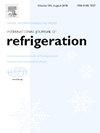Polyalphaolefin-based SiO2 nanolubricants: Thermo-physical and tribology investigations for electric vehicle air-conditioning system
IF 3.5
2区 工程技术
Q1 ENGINEERING, MECHANICAL
International Journal of Refrigeration-revue Internationale Du Froid
Pub Date : 2025-07-05
DOI:10.1016/j.ijrefrig.2025.07.008
引用次数: 0
Abstract
The polyalphaolefins (PAO) lubricant oil exhibits promising potential as a substitute for lubricants used in electric vehicle air-conditioning systems employing R134a and R1234yf. This paper presents an experimental study on PAO lubricant’s thermo-physical and tribological properties when dispersed with SiO2 nanoparticles. The dispersion of SiO2 nanoparticles in the PAO lubricant was achieved using a two-step method, with volume concentrations ranging from 0.01 % to 0.10 %. The SiO2/PAO nanolubricants were visually observed, and their thermal conductivity, dynamic viscosity, coefficient of friction (COF), and wear scar diameter (WSD) were evaluated using appropriate instruments. The study found that the SiO2/PAO nanolubricant exhibited excellent stability, as indicated by a zeta potential value of over 60 mV. Additionally, a minimal amount of sedimentation was observed during the visual examination after 30 days of preparation. The SiO2 nanolubricant exhibited a thermal conductivity of 4.42 % higher and a viscosity that is 8.72 % higher compared to pure PAO lubricant. The COF reduction exhibited the maximum value at 17.33 %, while the friction torque reduction reached its lowest value at 1.47 %. In conclusion, the SiO2 nanoparticles significantly impact the PAO lubricant’s tribological properties, reducing friction and wear while improving the thermal conductivity with little drawback with viscosity increment.
聚烯烃基SiO2纳米润滑剂:电动汽车空调系统的热物理和摩擦学研究
聚α -烯烃(PAO)润滑油作为R134a和R1234yf电动汽车空调系统润滑油的替代品,具有广阔的应用前景。本文研究了二氧化硅纳米颗粒对PAO润滑油热物理性能和摩擦学性能的影响。采用两步法实现了二氧化硅纳米颗粒在PAO润滑油中的分散,体积浓度范围为0.01%至0.10%。采用目测方法观察SiO2/PAO纳米润滑剂的导热系数、动态黏度、摩擦系数(COF)和磨损疤痕直径(WSD)。研究发现,SiO2/PAO纳米润滑剂具有优异的稳定性,zeta电位值超过60 mV。此外,在制备30天后的目视检查中观察到极少量的沉积。与纯PAO润滑油相比,SiO2纳米润滑剂的导热系数高4.42%,粘度高8.72%。COF减量最大,为17.33%,摩擦力矩减量最小,为1.47%。综上所述,SiO2纳米颗粒显著影响PAO润滑油的摩擦学性能,降低摩擦磨损,同时提高导热系数,且随着粘度的增加几乎没有不利影响。
本文章由计算机程序翻译,如有差异,请以英文原文为准。
求助全文
约1分钟内获得全文
求助全文
来源期刊
CiteScore
7.30
自引率
12.80%
发文量
363
审稿时长
3.7 months
期刊介绍:
The International Journal of Refrigeration is published for the International Institute of Refrigeration (IIR) by Elsevier. It is essential reading for all those wishing to keep abreast of research and industrial news in refrigeration, air conditioning and associated fields. This is particularly important in these times of rapid introduction of alternative refrigerants and the emergence of new technology. The journal has published special issues on alternative refrigerants and novel topics in the field of boiling, condensation, heat pumps, food refrigeration, carbon dioxide, ammonia, hydrocarbons, magnetic refrigeration at room temperature, sorptive cooling, phase change materials and slurries, ejector technology, compressors, and solar cooling.
As well as original research papers the International Journal of Refrigeration also includes review articles, papers presented at IIR conferences, short reports and letters describing preliminary results and experimental details, and letters to the Editor on recent areas of discussion and controversy. Other features include forthcoming events, conference reports and book reviews.
Papers are published in either English or French with the IIR news section in both languages.

 求助内容:
求助内容: 应助结果提醒方式:
应助结果提醒方式:


